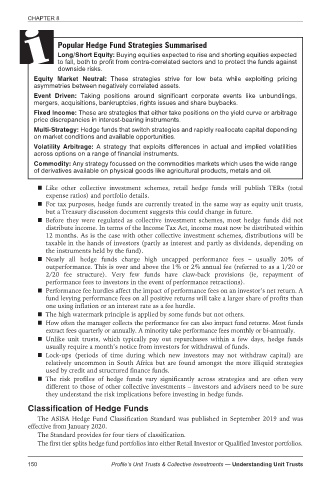Page 152 - Profile's Unit Trusts & Collective Investments - March 2025
P. 152
CHAPTER 8
Popular Hedge Fund Strategies Summarised
Long/Short Equity: Buying equities expected to rise and shorting equities expected
to fall, both to profit from contra-correlated sectors and to protect the funds against
downside risks.
Equity Market Neutral: These strategies strive for low beta while exploiting pricing
asymmetries between negatively correlated assets.
Event Driven: Taking positions around significant corporate events like unbundlings,
mergers, acquisitions, bankruptcies, rights issues and share buybacks.
Fixed Income: These are strategies that either take positions on the yield curve or arbitrage
price discrepancies in interest-bearing instruments.
Multi-Strategy: Hedge funds that switch strategies and rapidly reallocate capital depending
on market conditions and available opportunities.
Volatility Arbitrage: A strategy that exploits differences in actual and implied volatilities
across options on a range of financial instruments.
Commodity: Any strategy focussed on the commodities markets which uses the wide range
of derivatives available on physical goods like agricultural products, metals and oil.
Like other collective investment schemes, retail hedge funds will publish TERs (total
expense ratios) and portfolio details.
For tax purposes, hedge funds are currently treated in the same way as equity unit trusts,
but a Treasury discussion document suggests this could change in future.
Before they were regulated as collective investment schemes, most hedge funds did not
distribute income. In terms of the Income Tax Act, income must now be distributed within
12 months. As is the case with other collective investment schemes, distributions will be
taxable in the hands of investors (partly as interest and partly as dividends, depending on
the instruments held by the fund).
Nearly all hedge funds charge high uncapped performance fees – usually 20% of
outperformance. This is over and above the 1% or 2% annual fee (referred to as a 1/20 or
2/20 fee structure). Very few funds have claw-back provisions (ie, repayment of
performance fees to investors in the event of performance retractions).
Performance fee hurdles affect the impact of performance fees on an investor’s net return. A
fund levying performance fees on all positive returns will take a larger share of profits than
one using inflation or an interest rate as a fee hurdle.
The high watermark principle is applied by some funds but not others.
How often the manager collects the performance fee can also impact fund returns. Most funds
extract fees quarterly or annually. A minority take performance fees monthly or bi-annually.
Unlike unit trusts, which typically pay out repurchases within a few days, hedge funds
usually require a month’s notice from investors for withdrawal of funds.
Lock-ups (periods of time during which new investors may not withdraw capital) are
relatively uncommon in South Africa but are found amongst the more illiquid strategies
used by credit and structured finance funds.
The risk profiles of hedge funds vary significantly across strategies and are often very
different to those of other collective investments – investors and advisers need to be sure
they understand the risk implications before investing in hedge funds.
Classification of Hedge Funds
The ASISA Hedge Fund Classification Standard was published in September 2019 and was
effective from January 2020.
The Standard provides for four tiers of classification.
The first tier splits hedge fund portfolios into either Retail Investor or Qualified Investor portfolios.
150 Profile’s Unit Trusts & Collective Investments — Understanding Unit Trusts

